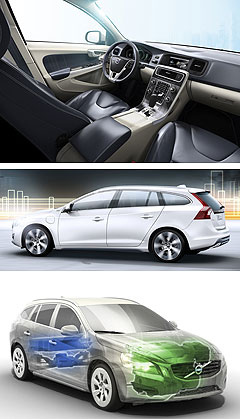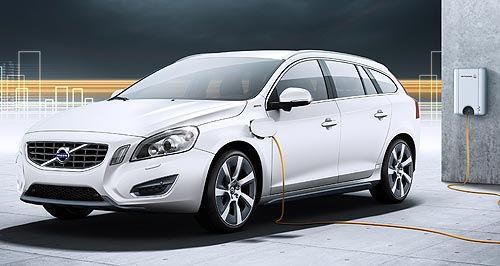Future models - Volvo - V60 - PHEVAIMS: Volvo confirms plug-in V60 for OzGreen Swede: The Volvo V60 plug-in hybrid will become the Scandinavian brand’s first electric vehicle in Australia within two years. Ground-breaking Volvo plug-in diesel hybrid will be Volvo’s first EV in Australia4 Jul 2011 VOLVO’S revolutionary V60 plug-in hybrid will become the Scandinavian brand’s first electric vehicle in Australia within two years. That is the word from new Volvo Cars Australia managing director Matt Braid, who revealed the production-ready V60 PHEV for the first time in Australia on Friday. “The V60 plug-in will likely be Volvo’s first EV in Australia,” Mr Braid told GoAuto after unveiling a prototype of the ground-breaking diesel-electric hybrid wagon that will enter production in Sweden next year. “We’d love to have it, depending on production volumes. There are a few hurdles to jump yet but if it’s not next year it will be in early 2013. “The business case has to stack up, but I’m very confident it will at some stage.” Both the V60 PHEV and C30 Electric will be produced in limited numbers, but the latter entered production early last month in Sweden – before the first examples are leased to European fleets from August – and was widely expected to be Volvo’s first EV in Australia.  However, Mr Braid said that, although Volvo was still studying the local release of the C30 EV, it was less of a priority than the V60 PHEV because production will be tight and battery-electric vehicles are less suited to Australia than plug-in hybrids. However, Mr Braid said that, although Volvo was still studying the local release of the C30 EV, it was less of a priority than the V60 PHEV because production will be tight and battery-electric vehicles are less suited to Australia than plug-in hybrids.Nevertheless, to highlight the safety of its EVs Volvo Cars Australia also displayed a C30 Electric after undergoing a 40 per cent frontal offset crash test at 64km/h at its parent company’s safety laboratory. “We were the first car-maker to show the world what a truly safe electric car looks like after a collision with high-speed impact,” said Volvo Cars president and CEO Stefan Jacoby after the crash test last December. “We note that not everyone that now launches or is in the process of launching electric cars are approaching the safety challenges as we are. But Volvo will never compromise on our stringent safety demands.” Volvo said that, despite the addition of a 300kg lithium-ion battery pack and 400-volt electrical system, the EV performed the same in the test as the C30 on which it is based. Volvo has conducted a field trial involving about 50 C30 Electric vehicles in Sweden since last September. It said it will produce about 250 examples this year, with initial production vehicles to be leased to companies, authorities and government bodies in Sweden, Belgium, the Netherlands and Norway from next month. The Volvo C30 Electric is built on the regular assembly line in Ghent, before being transported to Gothenburg for installation of the power electronics, 82kW electric motor and 24kWh battery pack, which replaces the conventional model’s fuel tank and leaves cargo space unchanged. Volvo says the C30 EV can be fully recharged via a regular household power outlet in about seven hours, providing a driving range of up to 150km, while 0-100km/h acceleration is a claimed 10.9 seconds and top speed is listed at 130km/h. “Currently we offer our small car customers the C30 DRIVe, which uses just 3.9L/100km and emits just 104g/km (of) CO2,” said VCA public affairs manager Jaedene Hudson. “The C30 Electric is the next step in green motoring from Volvo. We’ve seen the initial information from Volvo Cars Corporation and have expressed interest in the car. The next stage will be to put together a business case to see if the car will be viable in our market.” Meantime, the diesel-electric V60 plug-in wagon will be marketed across Europe from early next year, before being re-engineered with a petrol engine/generator for the US. Billed as the world’s first vehicle to combine a diesel-electric hybrid drive system with plug-in recharging technology, the production-ready V60 PHEV is claimed to return fuel consumption of just 1.9L/100km and CO2 emissions of only 49g/km. The V60 PHEV was developed in conjunction with Swedish energy supplier Vattenfall and offers a zero-emissions range of 50km in ‘Pure’ driving mode and a total range of 1200km. Driving the front wheels via a six-speed automatic transmission is a 160kW/440Nm five-cylinder 2.4-litre D5 turbo-diesel, while a 52kW electric motor – powered by a 12kW lithium-ion battery – is incorporated into an Electric Rear Axle Drive (ERAD). When combined in ‘Power’ mode, the drivetrains offer a total output of 200kW and 640Nm – enough for Volvo to claim 0-100km/h acceleration in 6.9 seconds. Battery charge time is claimed to be 4.5 hours with a 10-amp electric system – increasing to 7.5 hours with a 6A outlet and decreasing to three hours with a 16A system. Volvo said the C30 Electric and V60 PHEV were developed in tandem. “These two car types complement one another,” said Mr Jacoby. “With a plug-in hybrid the driver is entirely independent of recharging stations when driving long distances. The future electric car market will feature a mixture of both all-electric cars and plug-in hybrids.” Volvo claims that, because EVs use relatively little electricity, the increase in power consumption will be more than covered by ambitious expansion plans for renewable energy sources throughout Europe. It says renewable energy production is currently undergoing rapid expansion in Europe, where wind power is being commercialised on a large scale, biofuels will eventually replace fossil fuels, wave power is expected to be commercially viable within a decade and ‘clean-coal’-fired power stations are under development. In Sweden, Vattenfall will offer V60 PHEV buyers energy contacts that include electricity from renewable sources. Volvo said a single wind-power station, for example, produces enough energy to power 3000 EVs.  Read moreAll future models Alfa Romeo Alfa Romeo Abarth Abarth Alpine Alpine Alpina Alpina Audi Audi Aston Martin Aston Martin BMW BMW Bentley Bentley Chery Chery Brabham Brabham Chrysler Chrysler Chevrolet Chevrolet Cupra Cupra Citroen Citroen DS DS Dodge Dodge Fiat Fiat Ferrari Ferrari Foton Foton Ford Ford Great Wall Great Wall FPV FPV Haval Haval GWM GWM Honda Honda Holden Holden Hummer Hummer HSV HSV Infiniti Infiniti Hyundai Hyundai Jaguar Jaguar Isuzu Isuzu Kia Kia Jeep Jeep Land Rover Land Rover Lamborghini Lamborghini Lexus Lexus LDV LDV Mahindra Mahindra Lotus Lotus Mazda Mazda Maserati Maserati Mercedes-AMG Mercedes-AMG McLaren McLaren MG MG Mercedes-Benz Mercedes-Benz Mitsubishi Mitsubishi Mini Mini Opel Opel Nissan Nissan Peugeot Peugeot Pagani Pagani Proton Proton Porsche Porsche Renault Renault Ram Ram Rover Rover Rolls-Royce Rolls-Royce Skoda Skoda Saab Saab SsangYong SsangYong Smart Smart Suzuki Suzuki Subaru Subaru Toyota Toyota Tesla Tesla Volvo VolvoV60 pricing
Motor industry news |
Click to shareVolvo modelsResearch Volvo All future models Alfa Romeo Alfa Romeo Abarth Abarth Alpine Alpine Alpina Alpina Audi Audi Aston Martin Aston Martin BMW BMW Bentley Bentley Chery Chery Brabham Brabham Chrysler Chrysler Chevrolet Chevrolet Cupra Cupra Citroen Citroen DS DS Dodge Dodge Fiat Fiat Ferrari Ferrari Foton Foton Ford Ford Great Wall Great Wall FPV FPV Haval Haval GWM GWM Honda Honda Holden Holden Hummer Hummer HSV HSV Infiniti Infiniti Hyundai Hyundai Jaguar Jaguar Isuzu Isuzu Kia Kia Jeep Jeep Land Rover Land Rover Lamborghini Lamborghini Lexus Lexus LDV LDV Mahindra Mahindra Lotus Lotus Mazda Mazda Maserati Maserati Mercedes-AMG Mercedes-AMG McLaren McLaren MG MG Mercedes-Benz Mercedes-Benz Mitsubishi Mitsubishi Mini Mini Opel Opel Nissan Nissan Peugeot Peugeot Pagani Pagani Proton Proton Porsche Porsche Renault Renault Ram Ram Rover Rover Rolls-Royce Rolls-Royce Skoda Skoda Saab Saab SsangYong SsangYong Smart Smart Suzuki Suzuki Subaru Subaru Toyota Toyota Tesla Tesla Volvo VolvoV60 pricing
Motor industry news |















Facebook Twitter Instagram